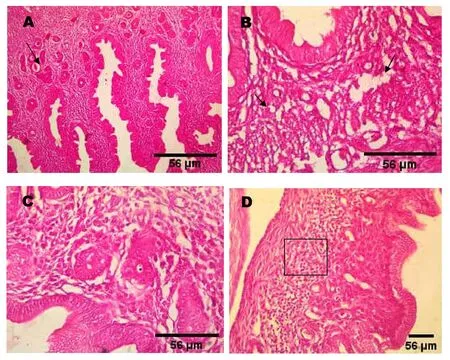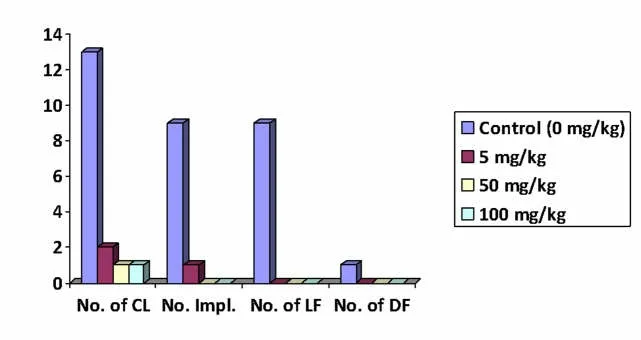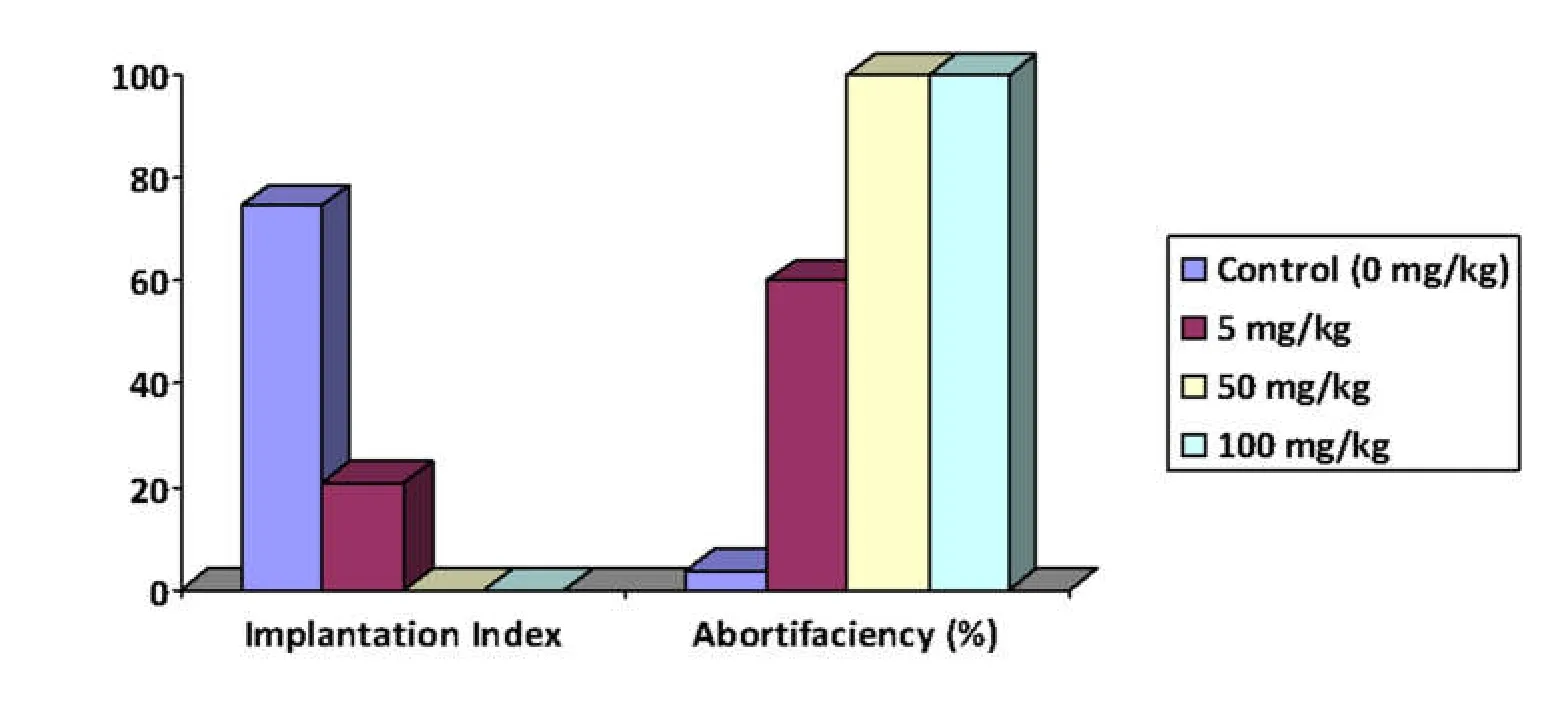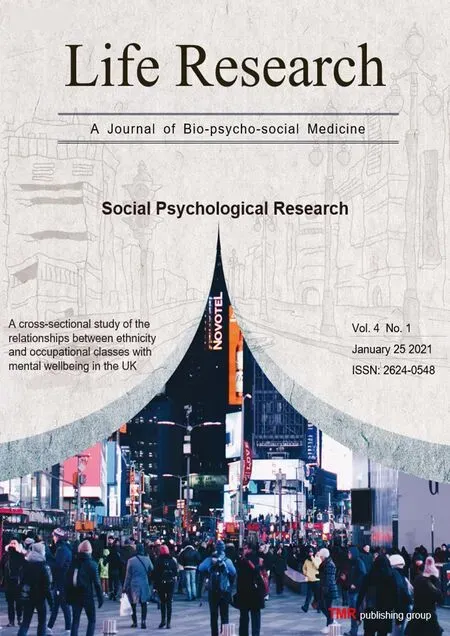Aqueous wood-ash extract of Parkia biglobosa causes reproductive toxicity in female mice
Timothy Auta
1Department of Biological Sciences,Federal University Dutsin-Ma,Katsina State,Nigeria.
Abstract Background:The traditional culture of eating wood-ash extracts in some countries has led to many health problems.The study assessed the anti-fertility effects of the aqueous wood-ash extract of Parkia biglobosa on female Swiss albino mice.Methods: Healthy female albino mice were procured and randomly grouped into four groups (5/group)where control,5,50 and 100 mg/kg doses of the extract were orally administered for 20 days and microscopy of vaginal smear carried out daily to determine anti-ovulatory activity.Oestrus cycle,including metestrus,diestrus and oestrus phases and histopathology of the uterus were examined daily and at the termination of the experiment.Results: At the end of the study,the highest number of circles (4.80 ± 0.20) was recorded in the control group,administered distilled water,while the lowest number of circles (3.00 ± 0.32) was in the 100 mg/kg dose group.Oestrus (5.80 ± 0.37) also is highest in the control group and lowest (1.20 ± 0.37) in the 100 mg/kg dose group.The group administered 100 mg/kg dose of the aqueous wood-ash extract of Parkia biglobosa had the highest diestrus index of 45,while the lowest of 17 was obtained in the control group.Histopathology of the uterus tissues shows a few degenerate epithelial cells in 50 mg/kg group and moderate dilatation of lumen and glandular epithelial cells in 100 mg/kg group.Conclusion: The study revealed dose-dependent anti-fertility effects of the aqueous wood-ash extract of Parkia biglobosa on female albino mice,which implies its potential reproductive toxicity in humans.
Key words:Wood-ash,Reproductive toxicity,Oestrus cycle,Implantation,Abortifacient
Background
Wood-ash is a by-product of wood-burning which is classed as a form of green energy production because it is both carbon neutral and renewable [1].Reports available have revealed its uses for medicinal,as a food additive,soap making,ripening of fruits,in agriculture and pest control among others [2-5].The wood-ash extract has been reported to be used for medicinal and food additive purposes among certain locals in the middle-belt region of Nigeria [1].In Chinese folk culture,some religions believed that eating incense ash(grass and wood ash) can cure intractable diseases after burning incense and pray for the gods.This superstitious practice is considered by many clinicians to be wrong and dangerous [6].In recent time,there has been an increase in concern about the reproductive toxicity of chemicals (and plant extracts) on developing reproductive system [7],in both males and females.A number of plants have been indicted to have antifertility,abortifacient,uterine stimulant,oestrogenic and cytotoxic activities in both animals and humans [8].The aqueous wood-ash extract ofAzadirachta indicahas been reported to have deleterious effects on sperm motility,count,morphology and pathological alterations of testes in male albino mice,hence compromising male fertility [9].In females,the aqueous wood-ash extract ofAzadirachta indicahas been reported to cause a dose-dependent alteration in oestrus cycle and implantation in femaleMusmusculus[10].The aqueous wood-ash extract ofParkia biglobosa(P.biglobosa)has been reported to contain high concentrations of polycyclic aromatic hydrocarbons and phytochemicals [1],which are considered to have deleterious effects on animals,including humans.In 2018,it was reported that exposure to aqueous woodash extract ofP.biglobosacaused dose-dependent depletion of spermatogenic cells in the testes of male Swiss albino mice [11].Even though the above reports and others exist,there is a dearth of information on the reproductive toxicity of aqueous wood-ash extract ofP.biglobosaon female albino mice.In seeking to bridge this information gap,this study assessed the antifertility activities of the aqueous wood-ash extract ofP.biglobosain female Swiss albino mice (Mus musculus),orally exposed to varying doses of the extract.
Methods
Diestrus index was calculated using the formula:

Collection of woods and preparation of ash and extract
FreshP.biglobosa(locust) wood was collected from Kaduna State,North-Western Nigeria.Stalk of the plant,carrying leaves and flowers,were collected and authenticated at the herbarium of Department of Biological Sciences,Ahmadu Bello University,Zaria,with a voucher number of 324.Collection and processing of wood ash were as described [1].
Selection of dose levels
The doses of 5,50 and 100 mg/kg,as used in this work were selected based on a range-finding test carried out.
Procurement and acclimatization of Mus musculus
A total of 60 healthy adultMus musculus(55 females and 15 males) were purchased from the animal house of Institute for Medical Advance Research and Training(IMRAT),College of Medicine,University of Ibadan,Oyo State for the sub-chronic and chronic toxicity studies.They were housed under standardized(temperature:28-31°C,photoperiod:approximately 12 hours natural light per day) animal house conditions and fed with standard mice feed and waterad libitum.The animals were randomly selected and kept in their cages to acclimatise for 2 weeks before the commencement of each experiment [12].Ethical approval,with reference number UI-ACUREC/App/2014/006 was obtained from the University of Ibadan Animal Care and Use for Research Ethical Committee (ACUREC).
Effects on ovulatory activity (oestrus cycle) and uterus histopathology
Study on effects of aqueous wood-ash extracts ofP.biglobosaon oestrus cycle was carried out using method described [10,13].Female mice (12 to 14 weeks of age)with normal oestrus cycle (average 4-6 days of proestrus,oestrus,metoestrus and dioestrus) were divided into 4 groups (n = 5/treatment group),totalling 20 mice.Mice in group 1 (control) received distilled water,while mice in groups 2,3 and 4 received 5,50 and 100 mg/kg bw/day doses ofP.biglobosaaqueous wood-ash extract/day for 20 consecutive days.Vaginal smears were examined daily during this period to check the oestrus stage [14].Persistent dioestrus,non-cyclic and lengthy oestrus cycles were considered as toxic signs.
Histopathology of uterus tissues
The tissues of uterus were excised and placed in Bouin’s fluid for 72 hrs to enable tissue hardening.They were then transferred to 10% phosphate buffered formalin for preservation; dehydrated in a series of ethanol dilutions and embedded in paraffin wax.Sections of 5 μm were cut and stained with Haemoxylin and Eosin (H&E) and observed under the microscope for routine histological examination.
Effects on early abortifacient activity and implantation index
Regularly cyclic female virgin mice (12 to 14 weeks of age) were selected to evaluate the effects ofP.biglobosawood-ash extracts on early abortifacient activity and implantation.Female mice were paired with males at the ratio of 3:1 for mating.Presence of copulation plugs the following morning were regarded as confirmation of mating.The day copulation plugs appeared was assumed the day one of pregnancy [13]and the mouse transferred to a labelled cage.Pregnant female mice were randomly divided into 4 groups (n =5/treatment).Mice in group 1 received distilled water while groups 2,3 and 4 received 5,50 and 100 mg/kg bw/day doses,respectively of aqueous wood-ash extract ofP.biglobosafrom day 1 to 7 of pregnancy.During pregnancy,the mice were evaluated for survival,altered appearance and any clinical signs of toxicity such as changes in food and water intake,piloerection,diarrhoea,changes of locomotor activity and vaginal bleeding.After the 10thday,female mice were anaesthetized in a desiccator with formaldehyde for 10 mins [9].Autopsies were performed.The number of corpora lutea,implantation sites and live/dead foetuses were recorded.
Implantation and abortion indices were calculated by the formula [15]:

Abortion (%) was calculated by the formula:

Statistical analysis
Data are expressed as mean ± standard deviation (SD)of the mean.One way analysis of variance (ANOVA)and Duncan multiple range test (DMRT) were used for analyses of data.The difference between the groups was considered significant atP< 0.05.All statistical analyses were conducted with Microsoft Office Excel 2007 and SPSS-16 for Windows.
Results
Effects on Ovulatory Activity
Results show mice exposed to aqueous wood-ash extract ofP.biglobosaexhibited a significant decrease(P< 0.05) in the number of cycles,proestrus and oestrus phases with an increase in concentration.Metestrus and diestrus phase decreased significantly with increase in concentration.Diestrus index decreased with increased in dose concentration (Table1).
Highest number of circles (4.80 ± 0.20) was observed in the control group,administered distilled water,while the lowest number of circles (3.00 ± 0.32) was in the 100 mg/kg dose group.Proestrus (6.20 ± 0.37) and oestrus (5.80 ± 0.37) also had their highest in the control group and lowest (2.40 ± 0.24 and 1.20 ± 0.37 respectively) in the 100 mg/kg dose group.In the reverse,metestrus and diestrus were lowest in the control group,4.60 ± 0.40 and 3.40 ± 0.24 respectively and highest in the 100 mg/kg dose group,7.00 ± 0.32 and 9.00 ± 0.32 respectively.The group administered 100 mg/kg dose of aqueous wood-ash extract ofP.biglobosahad the highest Diestrus Index of 45,while the lowest of 17 was obtained in the control group.
Histopathology of uterus tissues
Histopathology results of female mice uterus tissues exposed to aqueous extract ofP.biglobosawood ash at different concentrations revealed the ones in 5 mg/kg concentration of extract (Figure1B) to have mild oedema of the uterine stroma.The endometrial lining is composed of simple to low stratified cuboidal epithelial cells.Glands are simple columnar.Mice in the 50 mg/kg group (Figure1C) showed undulating endometrial lining composed of stratified columnar epithelium with a few degenerate epithelial cells; glands are stratified epithelium (Figure1C).The 100 mg/kg group (Figure1D) showed moderate dilatation of lumen; glands and endometrium lined by high columnar epithelium;moderate degeneration of epithelial cells of glands.

Table1 Effect of aqueous wood-ash extract of P.biglobosa on oestrous cycle in albino mice

Figure1 Photomicrograph of mice uterus exposed to aqueous extract of Parkia biglobosa wood ash.(A) Control,there is moderate dilation of lumen; glands and endometrium lined by high columnar epithelium and the glands show mild degeneration (arrow).(B) 5 mg/kg,there is marked luminal dilation,degeneration of epithelial cells of the endometrial lining (white arrow) as well as necrosis of the glands (arrows).(C) 50 mg/kg,the endometrial lining and glands are composed of active tall columnar epithelium.There is no degeneration of the lining cells.(D) 100 mg/kg,the endometrium is lined by simple columnar epithelium,with no degeneration of cells.There is mild oedema of the uterine stroma and infiltration of inflammatory cells (box).H&E.100X (A).400X (B-D)

Figure2 Showing the effect of aqueous wood ash extract of P.biglobosa on Corpora Lutea,implantation,live and dead foetus in mice.CL,corpora lutea; Impl,implantation; LF,live foetus; DF,dead foetus.

Figure3 Showing the effect of aqueous wood ash extract of P.biglobosa on Implantation Index and Abortifaciency
Effects on early abortifacient activity and implantation index
There was a significant (P< 0.05) decrease in the number of corpora lutea and the number of implantation with a dose concentration of aqueous wood-ash extract ofP.biglobosaadministered to the mice.Mice in the control group recorded the highest number of corpora lutea (12.80 ± 1.02),implantation (9.40 ± 0.51) and implantation index (74.53 ± 4.16),while the lowest were recorded in the group of 100 mg/kg,0.60 ± 0.24,0.00 ± 0.00 and 0.00 ± 0.00,corpora lutea,implantation and implantation index respectively.The number of live foetuses also showed significant difference with highest of 9.00 ± 0.32 in the control group and 0.00 ± 0.00 in both the 50 mg/kg and 100 mg/kg groups.On the contrary,the number of dead foetuses and abortion index significantly increased (P< 0.05) (Figures 2 and 3).Results obtained at the end of the study revealed varying reproductive toxicity caused by the administration of aqueous wood-ash extract ofP.biglobosaon female albino mice.
Discussion
Several medicinal plants are used by pregnant women for their therapeutic,preservative,or additive effects.These plants or their extracts are consumed mostly based on personal experience or traditional knowledge and in most cases.It is unclear whether is safe to use them during pregnancy [16].Study on toxicological activities or effects,after repeated exposures are required by regulatory agencies to characterize the toxicological profile of any substance,including plant and wood-ash extracts [17].There is a dearth of toxicological information on aqueous wood-ash extract ofP.biglobosain the literature to support and ensure its safe use.Thus,the present study presents the baseline information on the reproductive toxicity of aqueous wood-ash extract ofP.biglobosain female albino mice.
The regular number of circles recorded in the control group may imply normal oestrus cycle pattern.The irregular circles in the 100 mg/kg dose group reveal the dose-dependent alteration of the extract on oestrus cycle of the female mice,which may imply anti-ovulatory effects of the extract.This antifertility effect of the extract has also been reported for some plants of the Asteraceae family such asAchilleamillefoliumandAspiliaafricanawhich showed antispermatogenic and antiovulatory activities,respectively [15,16].The oestrus cycle is known to be a rhythmic reproductive cycle in sexually matured female mammals and is influenced by the release of gonadotropin releasing hormones from the pituitary gland and sex hormones from the gonads.While female cyclicity characterised by vaginal changes as observed in oestrus cycle is an index of good functioning of the neuroendocrine reproductive system and ovarian activity,the alterations of the normal oestrus cycle reported in this study imply ovarian progesterone and oestrogen balance was altered[18,19].The changes in the oestrous cycle observed:more days of the metestrus and diestrus phases and lower frequency of the oestrus phase; dose-dependent increase of diestrus index implies reduction in frequency of ovulation,which is a sign of impairment of fertility in the female mice [10],which will affect the ability of the female to conceive.
The presence of tannin,flavonoids,saponins and steroids in the aqueous wood-ash extract ofP.biglobosa[1] might be a contributing factor in the disruption of oestrus cycle.They have been reported to distort oestrus cycle [20].The endometrial changes in the uterus,the disarrangement of endometrium,endometrial stroma and reduction in endometrial height may be due to imbalance in hormonal level caused by the presence of phytoestrogens in the aqueous wood ash extract ofP.biglobosa[1],which are reported to have an antifertility effect.The number of dead foetuses and abortion index significantly increased that were higher in the 50 and 100 mg/kg implies the extract can induce abortifacient effect when consumed at an early period of pregnancy.Failure of implantation observed in this study could be attributed to alteration or interference in the production of hormones (oestrogen and progesterone).Thus,the lining of the uterus does not grow enough to support or nourish fertilized eggs,hence preventing implantation.It may also be due to the effect of the extracts on blastocysts or the final stage of implantation,probably due to alteration in the endometrial environment or a combination of both.Implantation can only be successful when the activated state of the blastocyst coincides with the receptive state of the uterus [10].Abortifacient activity of aqueous wood-ash extract ofP.biglobosaasobserved in this study may be attributed to the presence of flavonoids and other phytochemicals,which have been indicted in antifertility activity [10,21].It could also be due to uncontrolled uterine contractions,leading to abortion depending on the oestrogen levels in the tissues that could be due to uterotonic effects of the combination of enzymes [22].The significant reduction in the implantation and an increase in the preimplantation loss rate recorded in this,suggests a relaxing effect on the smooth muscles of the Fallopian tube,with interference in the transport of the blastocyst up to the uterus [23].
Conclusion
In conclusion,the findings of this study showed that consumption of aqueous wood-ash extract ofP.biglobosaby females may cause alteration in ovulatory activities,impairing the uterus and its consumption during pregnancy may increase the risk of abortion.Hence,its consumption by females needs to be checked.The study couldn’t analyse the hormonal and molecular(gene) toxicity of the wood ash extract on logistic grounds,and hence recommend such studies to ascertain the level of reproductive toxicity of this extract.
- Life Research的其它文章
- Science in Chinese medicine
- Artificial intelligence and the future of medicine:a multidimensional analysis
- Growth retrieval of stressed bacterial cells:logic and contradictions
- Amyloid beta peptides,tau protein acetylation and therapeutic strategies for treating Alzheimer’s disease:a review
- A cross-sectional study of the relationships between ethnicity and occupational classes with mental wellbeing in the UK
- Tear and serum electrolyte concentrations as a biomarker in primary glaucoma subjects

